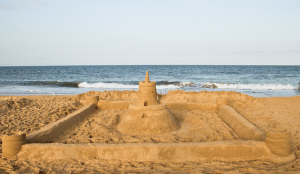
The glories of a sand castle lie in its walls… and moat system. CC image Sandcastle Competition courtesy of Victoria Pickering on Flickr. Some rights reserved.
I grew up near the coast, the child of two beach lovers. My childhood summer memories are filled with sand and salt, the smell of sunblock and the roaring sound of the surf as it crashed ashore. I was especially devoted to two activities at the beach: spending as much time in the water as possible, which included boogie-boarding, getting knocked on my butt, and general frolicking; and building sand castles. The number one feature of any good sand castle, in my view, aside from perfectly shaped towers that didn’t immediately crumble and collapse when I removed the bucket, was the moat.
The moat had to be filled with seawater to be truly special and worthwhile; the more of the moat we could fill with water, the better the moat and the more successful the sand castle. You could fill up the moat by hand, running back and forth from the surf with a bucket, but this method was time-consuming, tiring, and in the final analysis, futile. The water would always drain away, through the sand at the bottom of the moat (nicely porous) and/or via the front of the moat crumbling in the direction of the sea. Much more satisfying was building your sand castle and moat in such a way that the sea itself would fill the moat for you — via incoming waves.
Building a sand castle so that the ocean fills the moat for you is an exercise in basic planning and engineering. The castle needs to be close enough to a certain percentage of waves so that the moat can fill, but far enough from the pounding surf to last (every castle eventually succumbs to the sea; the question is only when, and in terms of Child Time, “long” is a flexible concept). To do this, you need to take into account whether the tide is going out, or coming in, and whether you have sibling helpers or obstructionists, or if everyone is going competitively solo. You have to plan your resources: for instance, there are a finite number of buckets and shovels for creating towers and moving sand. You have to accept that some parameters are beyond the builder’s control (the surf; your siblings; people who walk around not paying attention).
The same can be true of preparing for a writer’s residency: planning and preparation meet resource considerations and the reality of limitations on the writer’s ability to control all circumstances.
Why my residency is like a sand castle
When I first realized that my residency was real — not only had I been accepted, but I would be able to go — I immediately thought about how to best use the time I had to prepare. So many thoughts and ideas around the residency swirled through my head, I embarked on a weekly blog posting commitment to address my personal experience and share information that could be useful to other writers. I jumped in without much forward planning but a lot of ambition — the equivalent of pouncing on the first sand castle site available on the shoreline, without considering the number one rule of real estate: location, location, location.
I also didn’t count how many shovels and buckets I had available, and I ignored the reality of other life circumstances that place limits on my time.
As a result I can see a gap now of four weeks since my last blog post. Dear reader, in all this time, I have been writing… a lot. I have been writing every day. I have pages and pages full of notes, queries to myself, scenes and expository sequences. I meet and then exceed my word count. My story is starting to knit together and thrive under my devoted attention. I didn’t so much forget about my blog commitment, as realize that I had a bigger, more important commitment to attend to first.
Which brings me to the moat
When designing a moat for your sand castle, you can go for simple, a ditch that surrounds the outside perimeter, or you can opt for a complex network of canals and tributaries, feeding one another from the main moat. I’ve seen people with gorgeous sand castle canals, forking networks around complicated series of turrets, sometimes with an inner moat as well as an outer one. I’ve tried to build a few of these myself.
The trouble with fancy canal systems is that they require much more, and more regular, water. I’m sure an engineer and math enthusiast could calculate water volume, but in practice the relative amount of water is the key. You are dealing with a structure perched at the edge of the incoming or outgoing tide. The water will drain away unless replenished. If you have a big, deep moat, you can get by with more infrequent waves. Complicated networks of canals require more regular feeding, and are subject to increased decay because of the destructive force of the incoming water.
That’s how I currently feel about focusing on my residency manuscript at the expense of weekly blog posts. The blog posts are the complicated network of canals that require regular feeding; they siphon off water (creative energy and time) from the larger project. If I can pour more energy, in a concentrated amount of time, into my manuscript, I am better off than diverting all my resources into a network of shallow canals that require greater upkeep but produce less lasting results.
I think this is only natural. Larger projects demand larger amounts of our time. We have to engage with them in a different way from smaller, bite-sized responsibilities. Don’t be afraid to make a commitment.
== ==
When was the last time you gave yourself permission to focus on one big idea?
